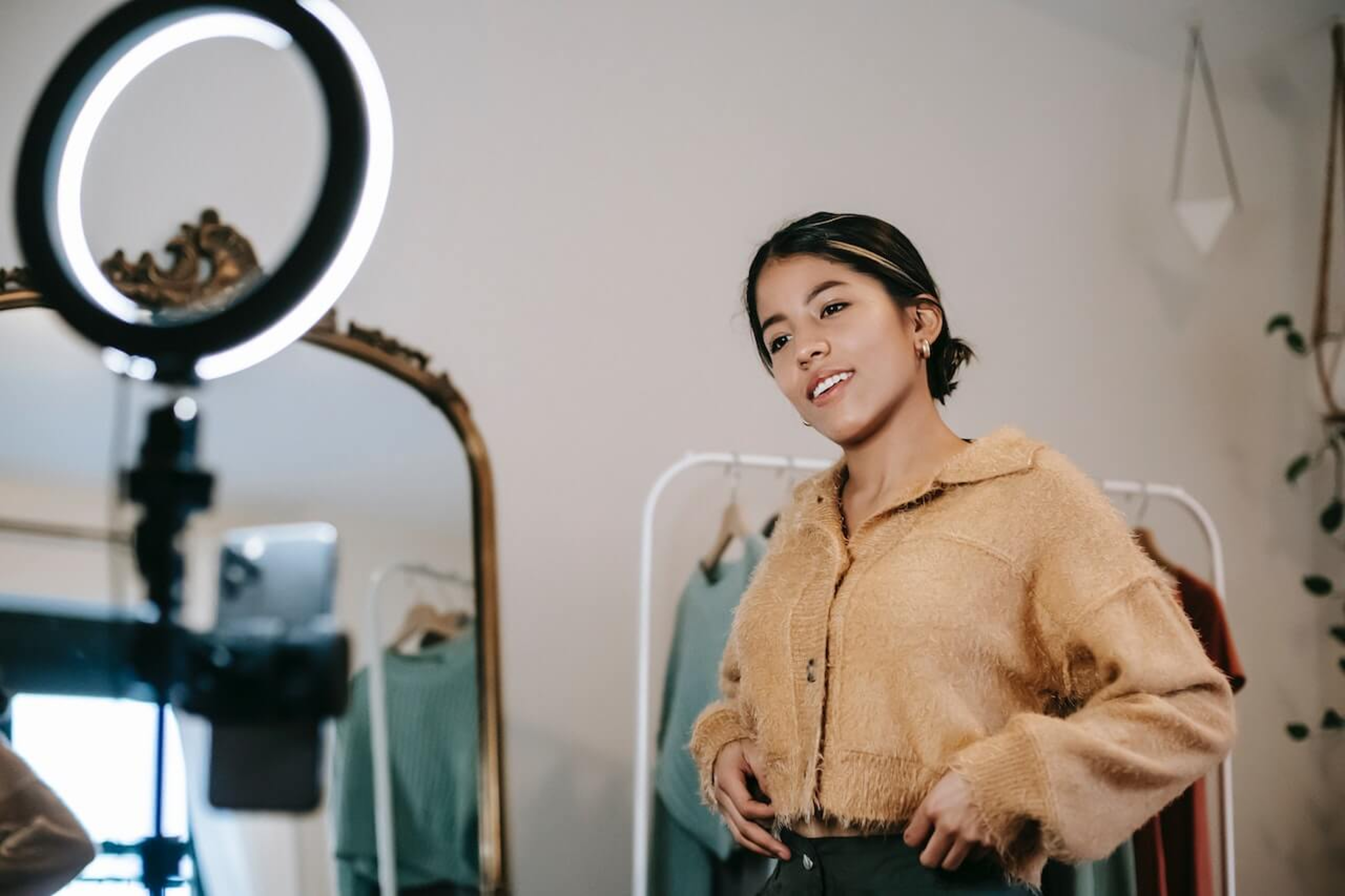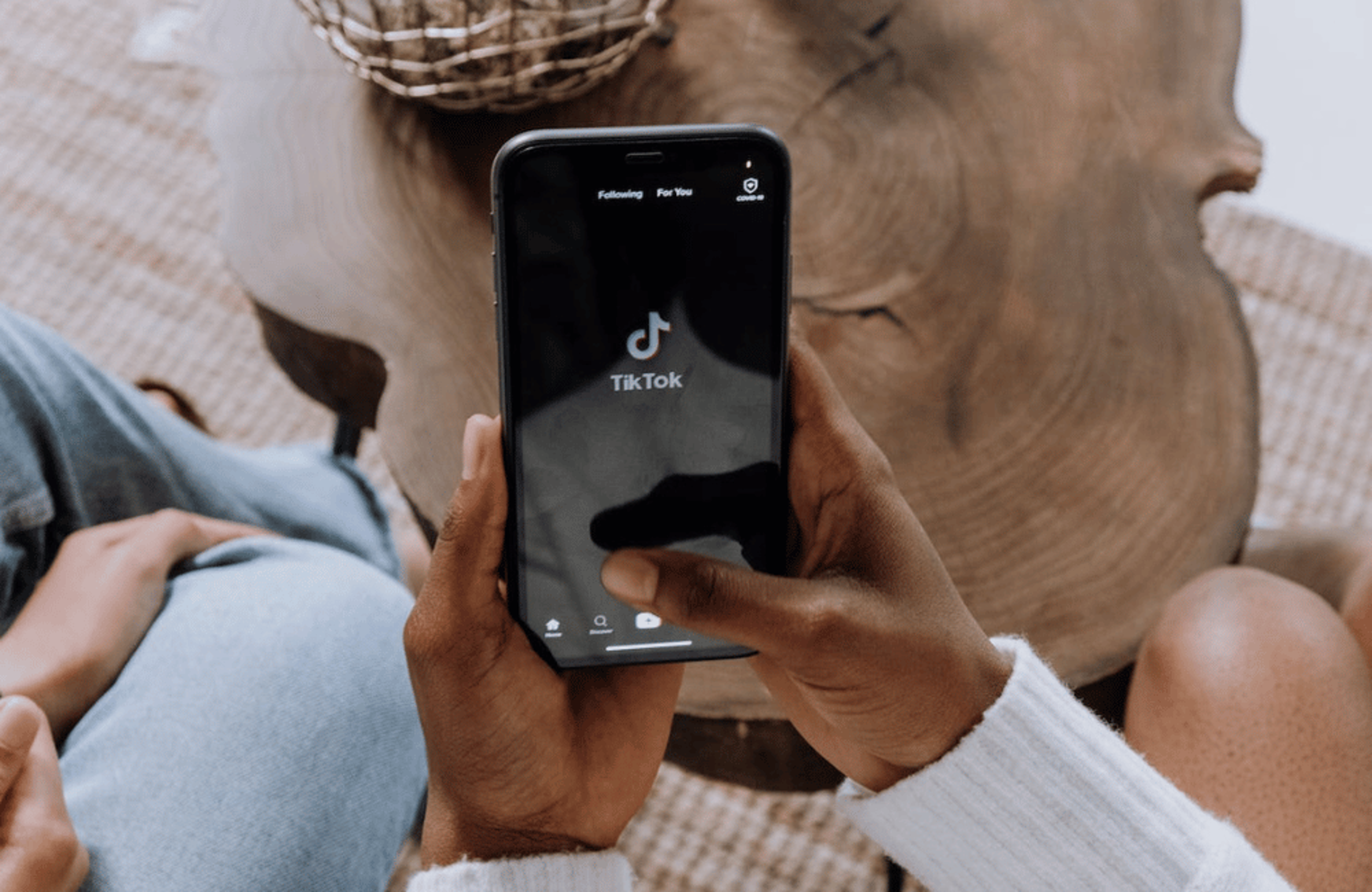Influencer marketing has become the darling of marketers to build brand awareness, connect with target customers, and even boost sales. The global influencer marketing market size has more than doubled since 2019. The current value? A whopping 21.1 billion USD.
There’s no doubt about it: Influencer marketing works.
But if you’re still baffled by the depths of influencer marketing, I don’t blame you. There’s so much to know, confusing conflicting advice, and plethora of tactics to keep up with.
With this A-Z ultimate guide on influencer marketing, you’ll know exactly what you need to do and how.
What is influencer marketing?
First, let’s cover the basics. Influencer marketing is when you ask a content creator with a sizable, engaged audience to promote your brand and its products. You can do influencer marketing to generate marketing assets, build brand awareness, or improve sales.
In return, you pay the influencer a flat rate, a commission for their sales, free products, or a combination of the above three.
For example, if you’re a fashion brand, you might collaborate with an influencer who creates content around outfit inspiration, like Kate Hutchins.
Who is an influencer (and who is not)?
Before we move ahead, let’s clear the air about who exactly is an influencer. It doesn’t need to be someone with millions of followers — it’s who has influence over the purchasing decision of your potential customers. The creator’s audience should turn to them for product recommendations and trust their advice.
For example, Lauren Mae has only 18.1K followers on Instagram (and 118K subscribers on YouTube). That might not seem like a lot, but her followers trust her reviews and are confident in her recommendations.
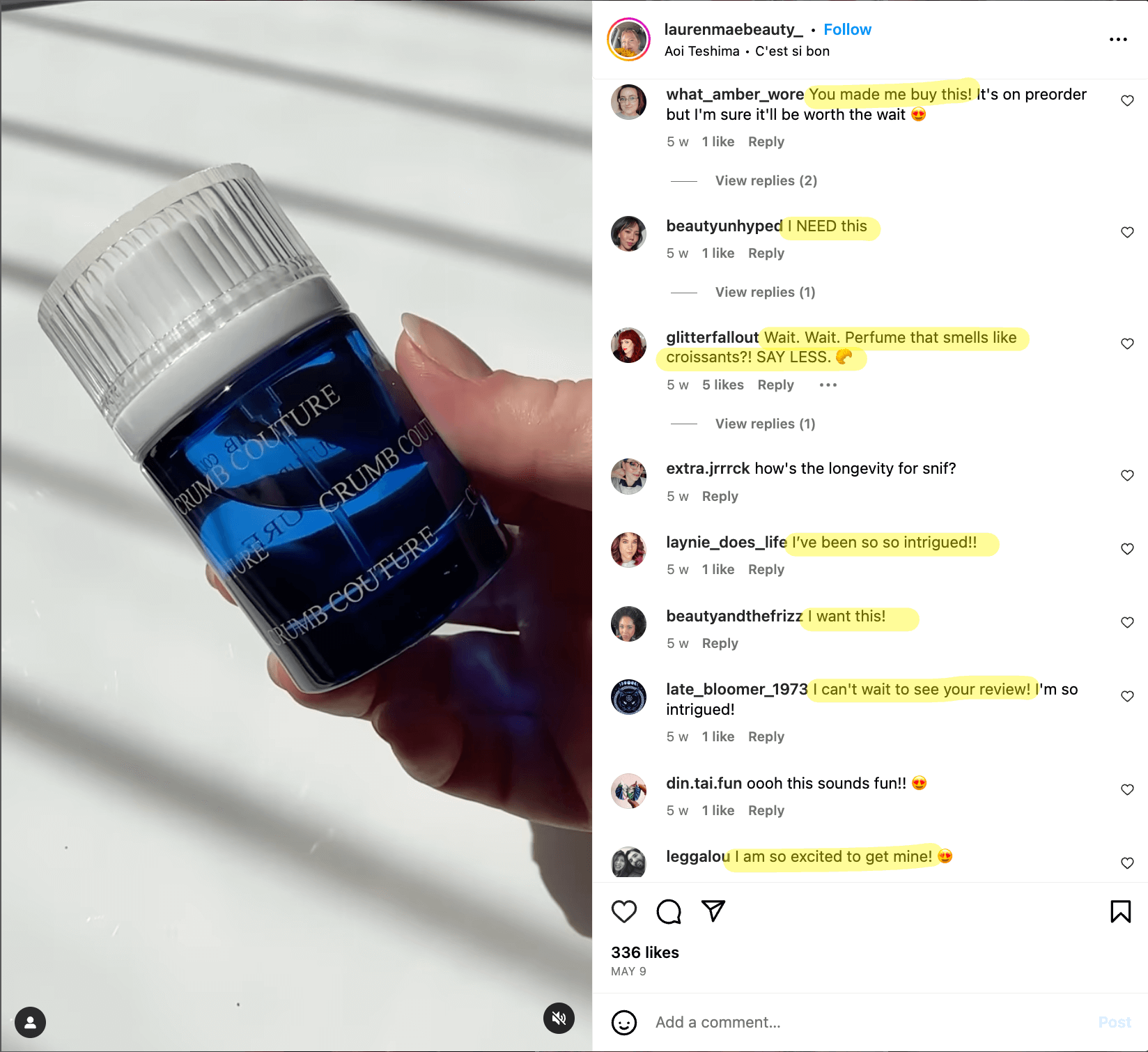
Whether you’re planning to hire a big-name celebrity or an online personality, remember: Popularity doesn’t always translate to influence.
Is influencer marketing worth the hype?
A resounding yes.
The right influencers come with built-in social proof — when you form a partnership with such creators, you borrow the trust they’ve built with their audience for years. That stamp of approval is priceless to gain the reputation of a reliable brand among your potential customers.
Not to mention: You get to tap into new audiences of your potential customers.
Multiple studies have proved the power of influencer marketing:
- A report by TikTok confirmed 64 percent of its users had bought a product after watching a creator advertising it.
- A survey by Izea found more than half of the respondents had purchased a product because they saw a social media influencer using it.
- The same survey also had 35 percent of respondents saying that influencer posts are the number one way to get them to try new products.
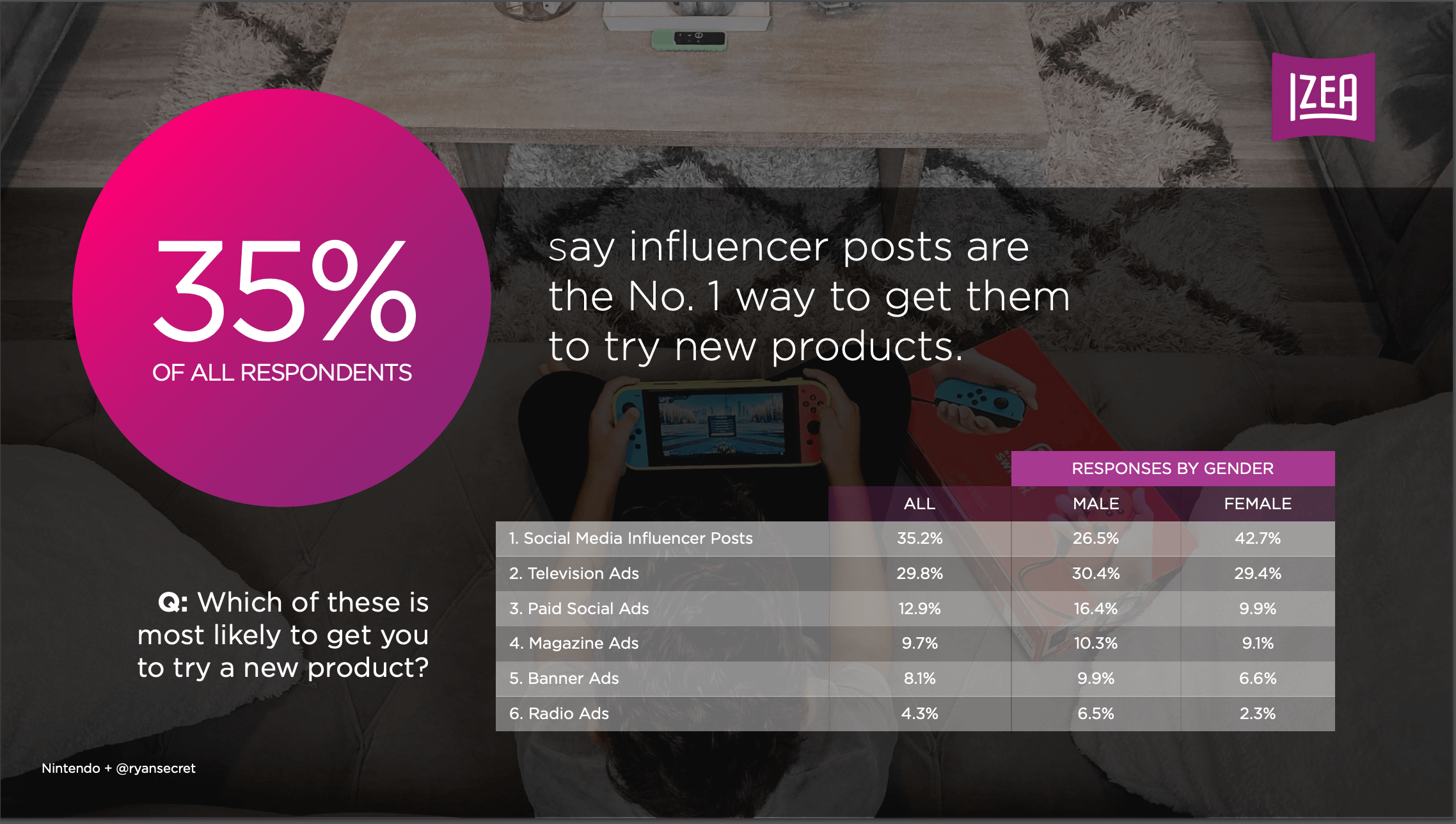
Influencer marketing is worth the buzz that surrounds it. But getting the best results out of it is no cakewalk. You need a well-thought-out, customized influencer marketing strategy to get the most bang for your buck.
How to create an impactful influencer marketing strategy?
The success of your influencer marketing campaign is entirely dependent on your strategy. Your influencer marketing plan can’t be the cookie-cutter guidelines followed by big brands — it has to be customized to your target audience, budget, and goals.
Here is how to make the influencer marketing strategy for your company in five steps:
Step 1: Get crystal clear on your influencer marketing goals
What does the success of influencer marketing look like for your brand?
Your answer dictates what kinds of creators you partner with, how you run your influencer marketing campaigns, and which metrics you track to measure performance.
For example, clothing brand Son de Flor practiced influencer gifting to generate awareness about their summer sale — partnering with creators such as Barbara, Rebeka Markewich, and Bront-Marie.
Your influencer marketing goals will also be dependent on your overall business objectives. If growing revenue is critical to the business at this stage, influencer marketing should be geared toward that too.
Based on your campaign goals, decide what metrics you can measure to check whether you’re on track. These metrics become your key performance indicators (KPIs).
For example, suppose you’re an ecommerce business aiming to grow revenue by increasing the average order value (AOV). In that case, your influencer marketing KPI can be: “Increase AOV by [XX%] from collaborating with [YY] influencers by [DDMMYYYY].”
This KPI will help you determine how close (or far) you are to reaching your goals.
Learn more: 9 Social Media Goals You Can Set for Your Business (and How to Track Them)
Understanding where influencer marketing fits into your overall marketing strategy and business objectives will help you build a solid foundation. Now, you have clarity on the destination you want to go to rather than aimlessly following a generalized map.
⚡Remember: Focus only on “what” you want from your influencer marketing efforts in this step. “How” you accomplish it will come in later.
Step 2: Map your ideal influencer and collaboration
The second step is figuring out the best path toward accomplishing your influencer marketing goals.
For example, if your influencer marketing KPI was to “boost sales by 25 percent for new product launch in three months,” your action plan might be collaborating with creators and giving them trackable affiliate links or discount codes.
Side note: Use Buffer’s UTM builder to track all unique influencer links and attribute website traffic to the right source. Create a campaign using the tags feature and customize the tracking under settings.
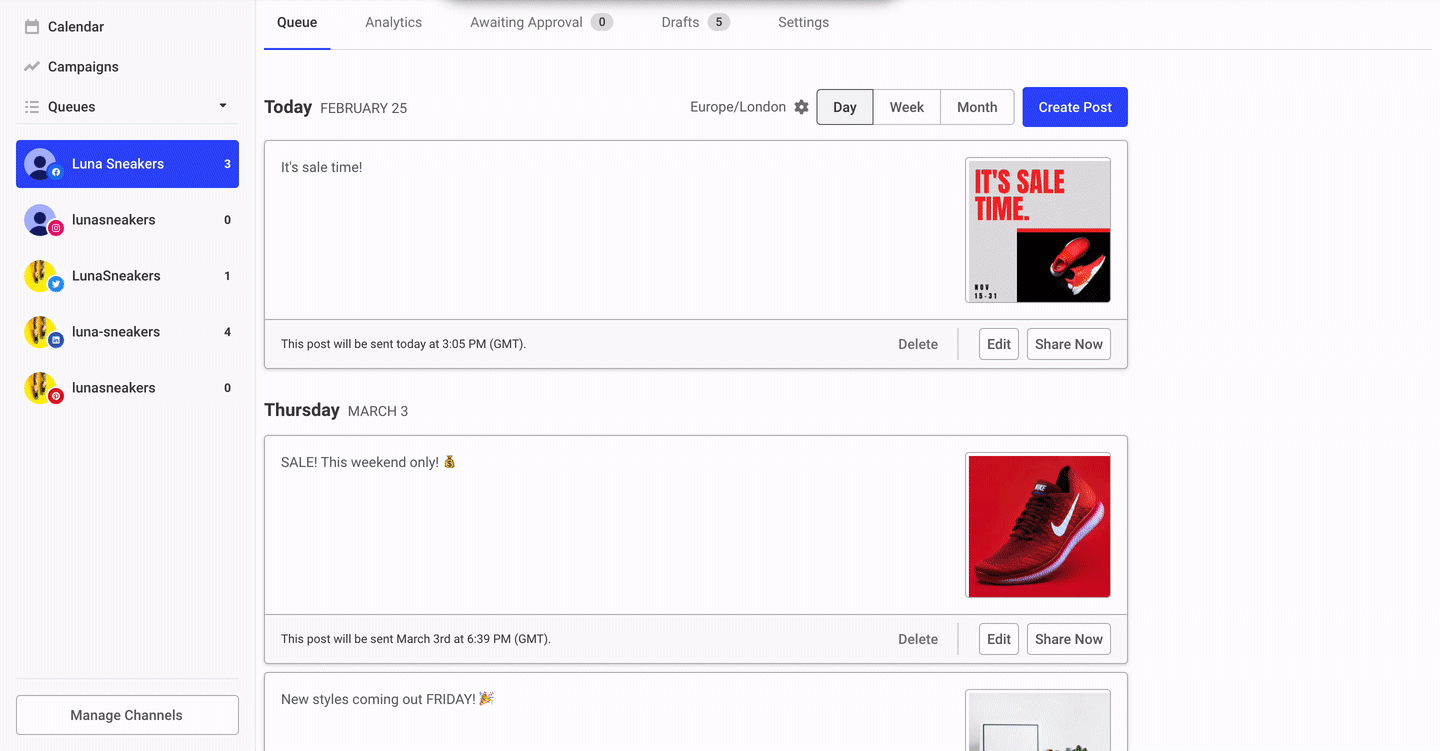
Learn more: How to Track Every Link and All the Traffic From Social Media
You need to determine four things to map your ideal influencer partnership(s):
- Platform(s) for running your influencer marketing campaigns
- Type of collaboration you can do to accomplish your goals
- Size of influencers you’d look for based on your budget
- Number of creators you can partner with
Let’s explore these four things in more detail.
1: Platform(s) for running your influencer marketing campaigns
You can do influencer marketing on plenty of social media sites today — Instagram, TikTok, YouTube, Pinterest, Twitter, LinkedIn, blogs, and even newsletters.
Although some platforms might be more well-known than others for influencer marketing, there’s no one right answer to which platform you should choose.
Find out where your potential customers hang out and dedicate your influencer marketing budget to creators on that platform.
If you’re a B2B business, your target customers might be more actively looking for your product on Twitter, LinkedIn, and leading industry blogs than on TikTok or Instagram.
For example, Reforge is a company that sells courses taught by tech experts. Their audience is likely to take action by reading trusted newsletters like Why We Buy. On sponsoring this newsletter, Reforge found more than 85 percent of the traffic driven to be qualified and meaningful.
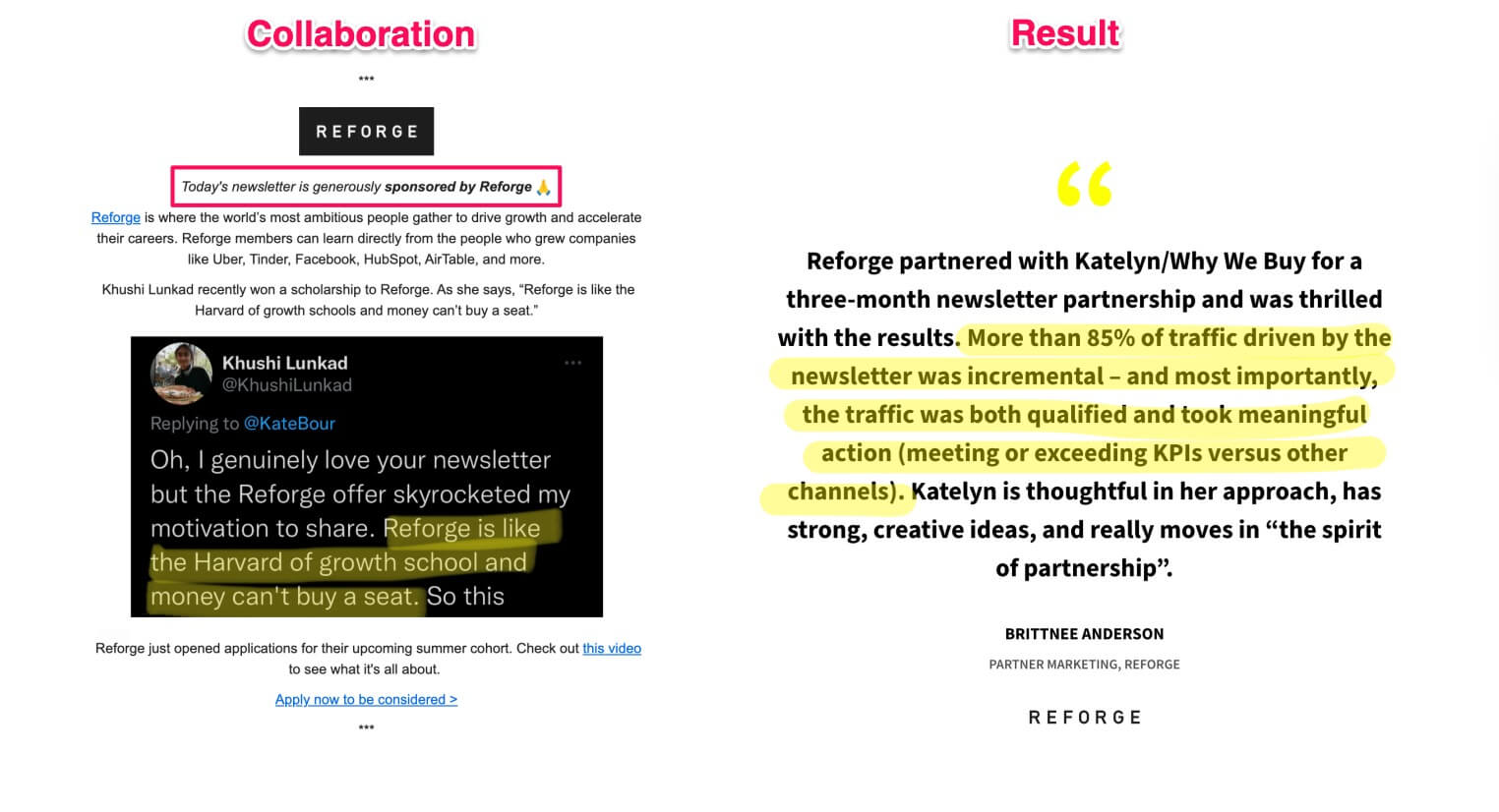
Don’t hunt for popular social influencers just because your competitors are. Do some audience research and find where your customers like to hang out and who are their trusted sources of influence. You might discover creators like Katelyn Bourgoin (Why We Buy’s writer) are more impactful than irrelevant celebrity endorsements through Instagram posts.
And remember: You don’t have to stick to one platform in your influencer marketing efforts. It helps to have a wider presence. But it’s best to start slow — run influencer campaigns on one platform, learn valuable lessons about what works, and then move on to the next platform.
2: Type of collaboration you can do to accomplish your goals
There are many types of influencer partnerships you can do. Here are the top five:
There are other forms of creator partnership, too — like co-creating products with an influencer or Instagram takeovers. You can also mix and match various types of influencer endorsements — like money expert Tori Dunlap and custom clothing brand Dalya did a giveaway of a co-created blazer.
Which type of collaboration should you create with influencers? It depends on your budget and campaign goals. Product seeding and affiliate partnerships are for companies with small budgets that want to get influencer-generated content and/or sales. Giveaways are the ideal choice when you want to generate buzz about a particular launch.
Kynship, an influencer marketing agency, recommends choosing your influencer collaboration method based on your yearly business revenue. They call it their influencer marketing pyramid structure.
Maybe you can’t follow this playbook to a T — because influencer marketing budgets vary even in brands with the same yearly revenue. Take it with a grain of salt — use it as a reference to see what might work out best for you and alter it to fit your requirements and constraints.
The best teacher is trial-and-error to see which type of creator endorsements get you the best return on investment (ROI).
⚠️ Remember: No matter what type of influencer collaboration you choose to do, display it correctly under FTC guidelines.
3: Size of influencers you’d look for based on your budget
There are four kinds of influencers divided by follower count.
⚠️ Note: These are generally accepted categorizations. Many companies differ in how they divide influencers by follower size. Some data also has a fifth mid-tier influencer with a following range of 50,000 – 500,000.
You might think the more followers an influencer has, the more positive results they can get for your brand. Isn’t the best influencer the one with the highest follower count?
The reality is different: Smaller influencers (nano-influencers and micro-influencers) have higher engagement rates compared to bigger influencers. Why? Smaller influencers have more relatability. It’s easier to feel like you have something in common with a busy parent than with Gigi Hadid.
A 2019 survey found 72 percent of its respondents prefer micro-level social media influencers over larger celebrity influencers. Another reason smaller influencers supersede bigger influencers is authenticity — a Morning Consult report confirmed 88 percent of people value authenticity over a large following.
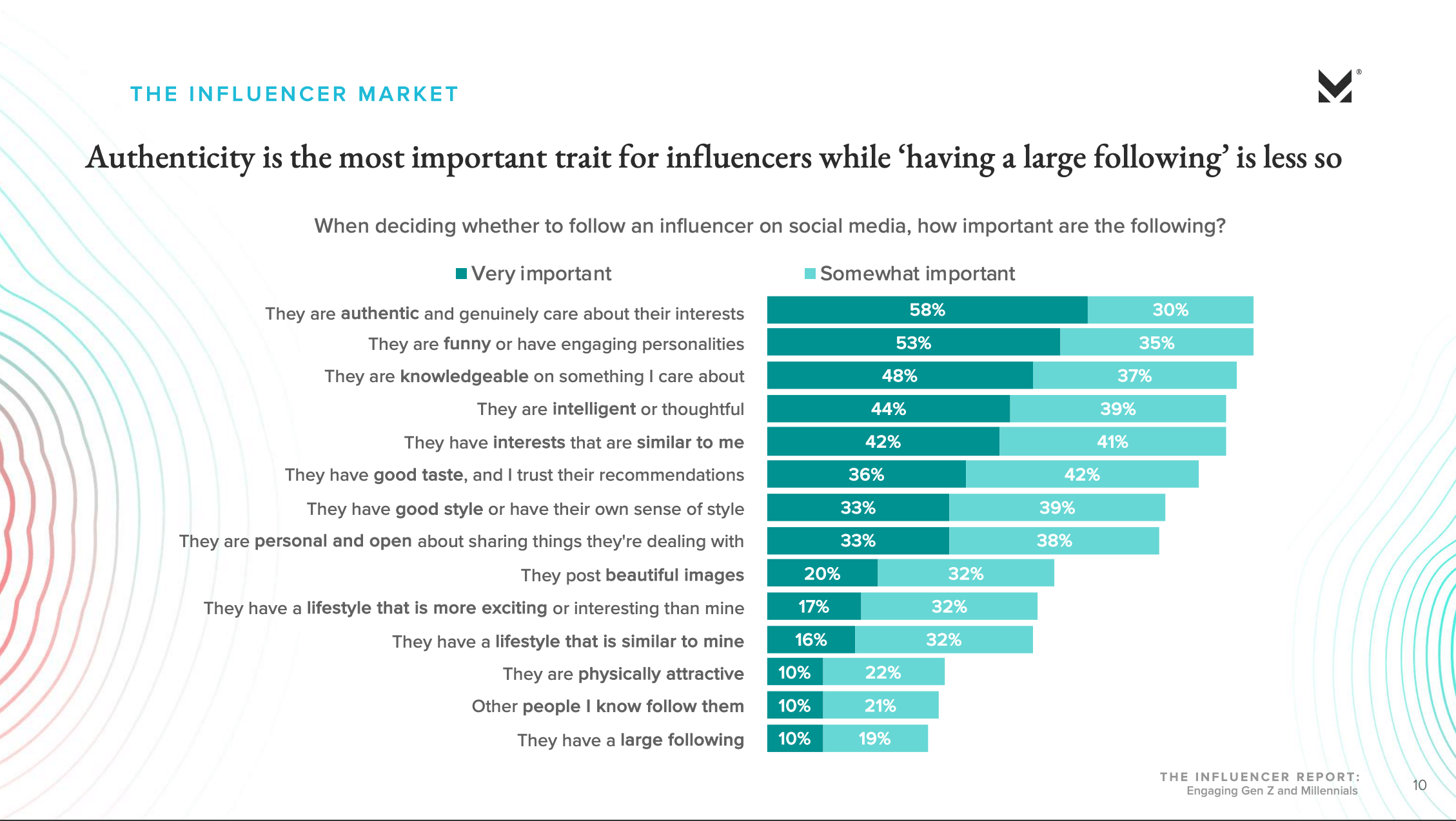
Take what happened with mega-influencer, Alisha Marie: She promoted the skincare brand Clean & Clear in one of her YouTube videos when her followers called her out for inauthenticity. They knew a big influencer like her doesn’t use a cost-effective brand like Clean & Clear because she had previously done a non-sponsored video about her skincare routine, and Clean & Clear was nowhere in sight.
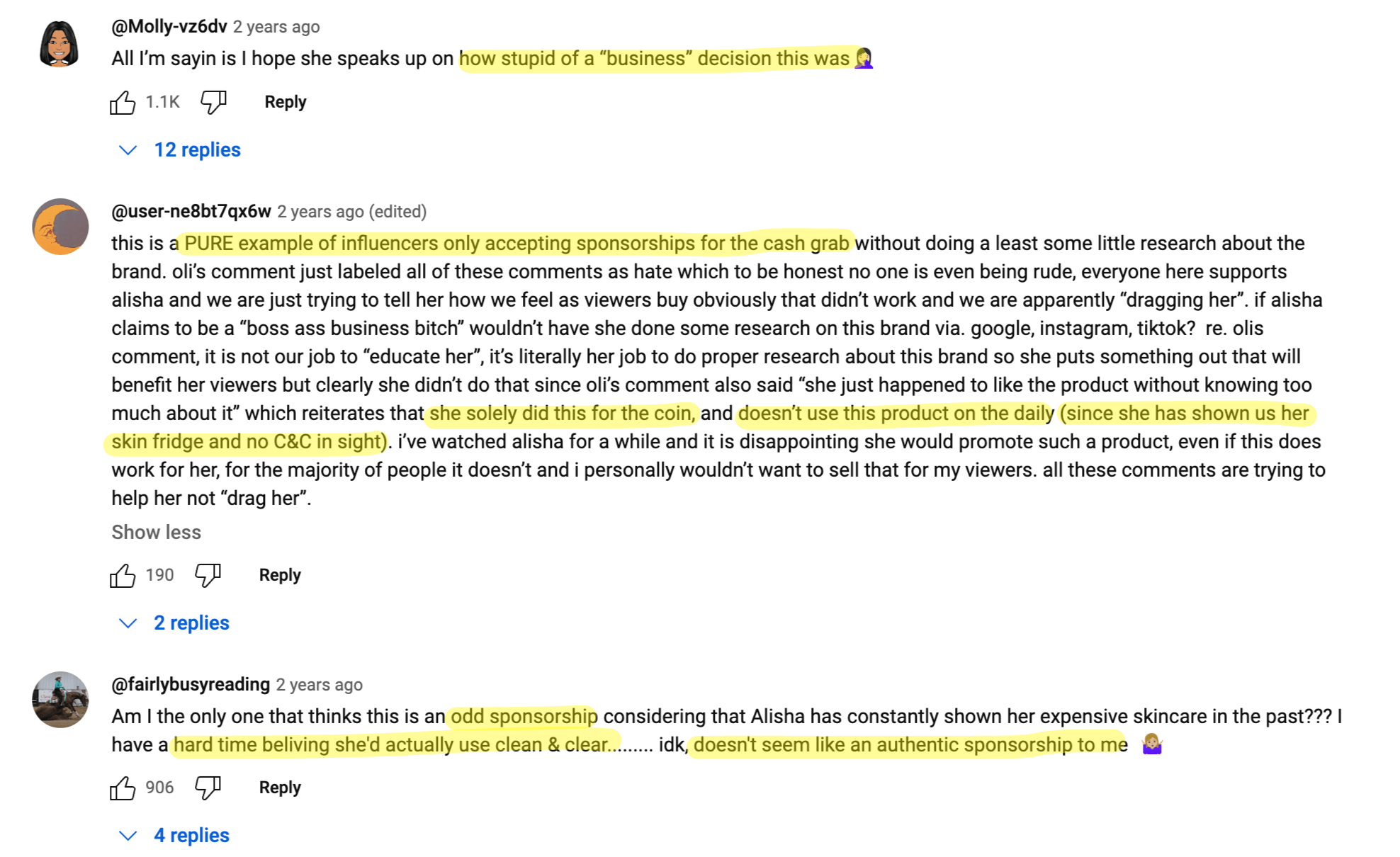
This isn’t a case for discounting the impact of successful influencers with large followings. They can certainly make a dent and improve your brand’s reach at scale. But small businesses and startups can see a significant impact by collaborating with a large volume of nano and micro-influencers.
Take cleaning products brand, Purdy & Figg: They practiced product seeding for over 2,000 micro-influencers when they began their influencer marketing campaigns. The result? An astonishing 690 percent increase in total orders.
You should also consider partnering with nano and micro-influencers because they’re cost-effective, have less red tape (no agents are typically involved), and have a more niche audience.
Even if you have some wiggle room in your budget, incorporate a mix of both smaller and larger influencers in your campaigns.
4: Number of creators you can partner with
The last piece of the puzzle is determining how many creators you can partner with across each platform. You might have fewer influencer partners if you’re also extending your creator family to include macro-influencers. If you’re sticking to only nano and micro-influencers, the total number of influencer partners might be higher for you.
Remember to not only think about your budget here. Also think of your general social media team bandwidth. Managing each influencer relationship takes a ton of work — contract, guidelines, tracking, and admin. If you’re a small team, be mindful of how many influencers you can manage realistically.
You can also consider outsourcing some tasks to software, agencies, and freelancers.
- Many marketing tools can help with influencer discovery, content tracking, and outreach
- Agencies can take complete or partial control over your influencer marketing campaigns
- Freelancers can assist with finding influencers and vetting their profiles
You lighten your workload for all options, but it costs extra, and you may lose some control over the process.
Step 3: Find relevant influencers
The influencers you choose can make or break your influencer marketing campaigns — they’re the most important piece to get right. But for companies who run campaigns in-house, finding the right influencers is the biggest challenge, according to a report by Influencer Marketing Hub.
There are a plethora of marketing tools in the market to help you with influencer discovery. But the issues with most of these influencer marketing platforms are:
- they have a huge learning curve
- they have a limited influencer database
- they tie you into expensive yearly contracts
Modash and SARAL are two tools with monthly plans, transparent pricing, and a vast influencer database. If you have a large budget and require agency support too, Fohr might be worth checking out. Evaluating other tools? Check if they are:
- Under your budget (some tools go upwards of $25,000/annually)
- Not just a creator marketplace (a creator marketplace means they require influencers to sign-up on their platform to be displayed, significantly shrinking the creator pool)
- Offering a deep influencer analysis (with metrics like engagement rate, example sponsored posts, and audience insights)
Even with the helping hand of tools, you must thoroughly vet each influencer profile to determine if they’d fit your brand. Here are five quantitative and qualitative questions you should be asking to evaluate each creator in your shortlist:
Do their audience demographics overlap with your target market?
Most influencer marketing platforms provide audience breakdown. If you want a more trusted source, you can ask the influencer for their media kit — which will contain insights into their audience.
Does the influencer have a high engagement rate?
A high engagement rate depends on the social media platform and the size of the influencer. Dash Hudson found TikTok’s average engagement rate to be 4.7 percent, Instagram’s 3.3 percent, and YouTube’s 3.7 percent. Set a benchmark of at least two percent for every influencer you evaluate. Engagement rate calculators by Modash (for Instagram) and GRIN (for TikTok and YouTube) can help.
Does the creator have fake followers?
Since influencers are paid in part for the size of their audience, many resort to buying followers and engagement to pump up their metrics.
There are plenty of fake follower checker tools out there, but you can also make this a qualitative check:
- Go through the comments on a popular post by the influencer. If it’s filled with generic statements like ‘nice pic’ or emojis, it’s a red flag that the comments are by bots. Organic marketing doesn’t look like that — it’ll have relevant comments related to the post.
- Some posts have a lot more engagement (likes, comments, shares) than their standard posts. The influencer might have gone viral, or they might’ve bought engagement.
- The follower-to-engagement ratio is off. If an influencer has 100K followers, but only 5K likes on their posts, it’s a sign they might’ve purchased followers.
⚠️ Note: Having at least some fake followers is expected because of bots on nearly every social media channel. Don’t get swayed by a few fake followers; just keep your eyes open for an unusually large number of them.
Does the influencer engage with their audience via Stories, comments, and DMs?
You don’t want to partner with an influencer who’s not in touch with their audience.
Check the comments and Stories by the influencer:
- Do they use features like Q&A to help their audience?
- Do they take the time to respond to their followers’ questions?
- How often do they show up on Stories answering queries they might’ve received in their DMs?
A creator can’t respond to every comment and DM, but the influencer should respond actively to as many comments and DMs as possible. Ultimately, it shows how much personal connection and trust exists among the influencer and their audience.
Does the influencer align with your brand’s values?
High-quality content creation isn’t the only benchmark you should be looking at. A creator can produce top-notch content and still be a misfit for your influencer marketing campaign.
Check the non-sponsored content of the influencer and see if it overlaps with your brand voice.
Dig a little deeper to know what the influencer’s values are. What personal stories do they talk about? What values show up in their content and audience interaction? This should align with what your brand stands for.
Brand alignment is a qualitative check — you’re essentially checking if your “vibes” will match with the influencer. But it’s an important question to evaluate to ensure a partnership that doesn’t seem forced.
Don’t want to use an influencer marketing platform for discovering influencers? Here are three no-software methods:
1: Hashtags and search
Hashtags are relevant on Instagram, YouTube, and TikTok. If you’re a beauty brand, for instance, search for hashtags such as #beautyproducts or #beautybloggers.
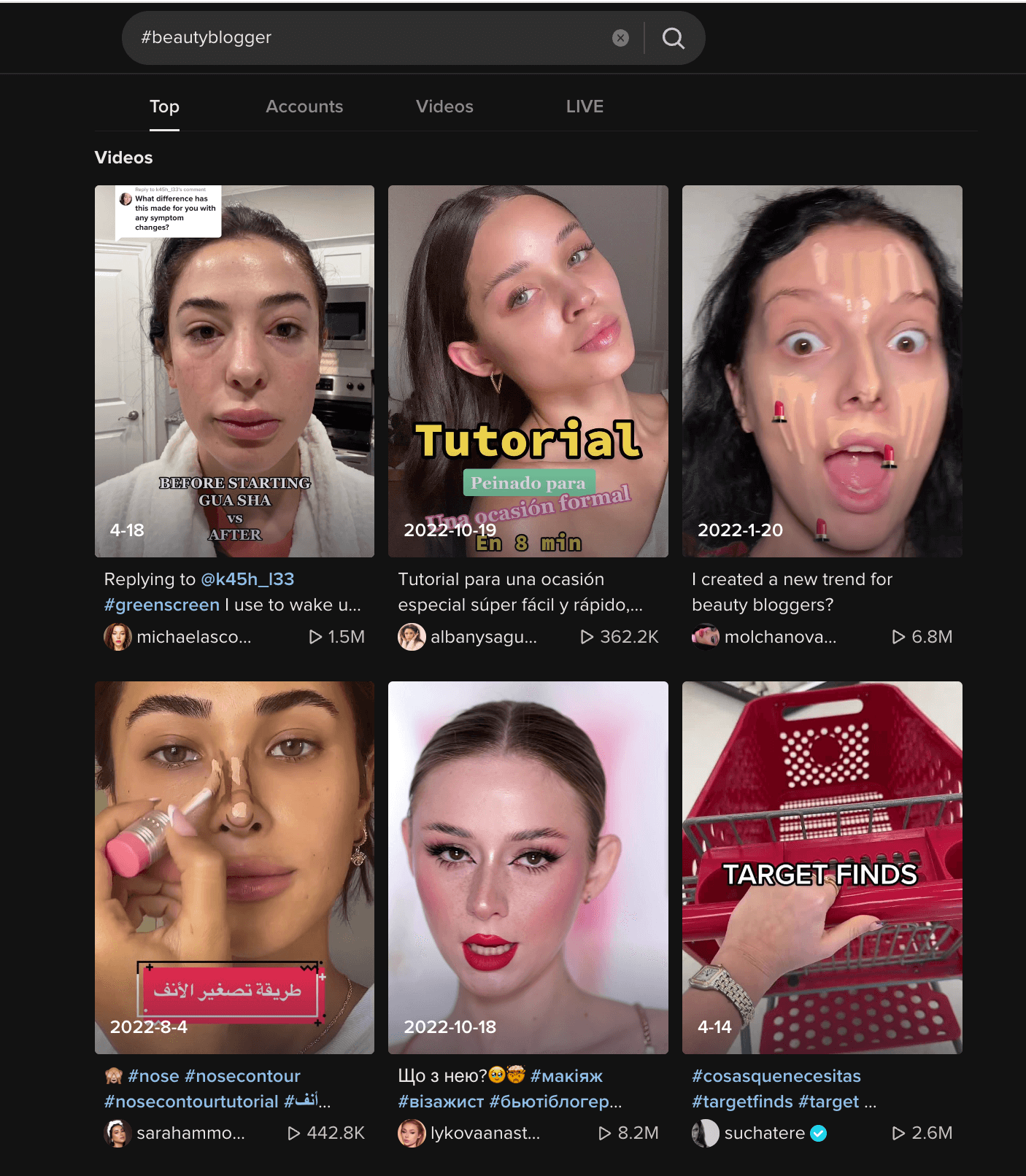
Choose both niche and generic hashtags to search more thoroughly and unearth more creators.
Simply searching for relevant keywords also works on Instagram, YouTube, and Pinterest. Top-performing, relevant content will show up from various creators — who you can then evaluate.
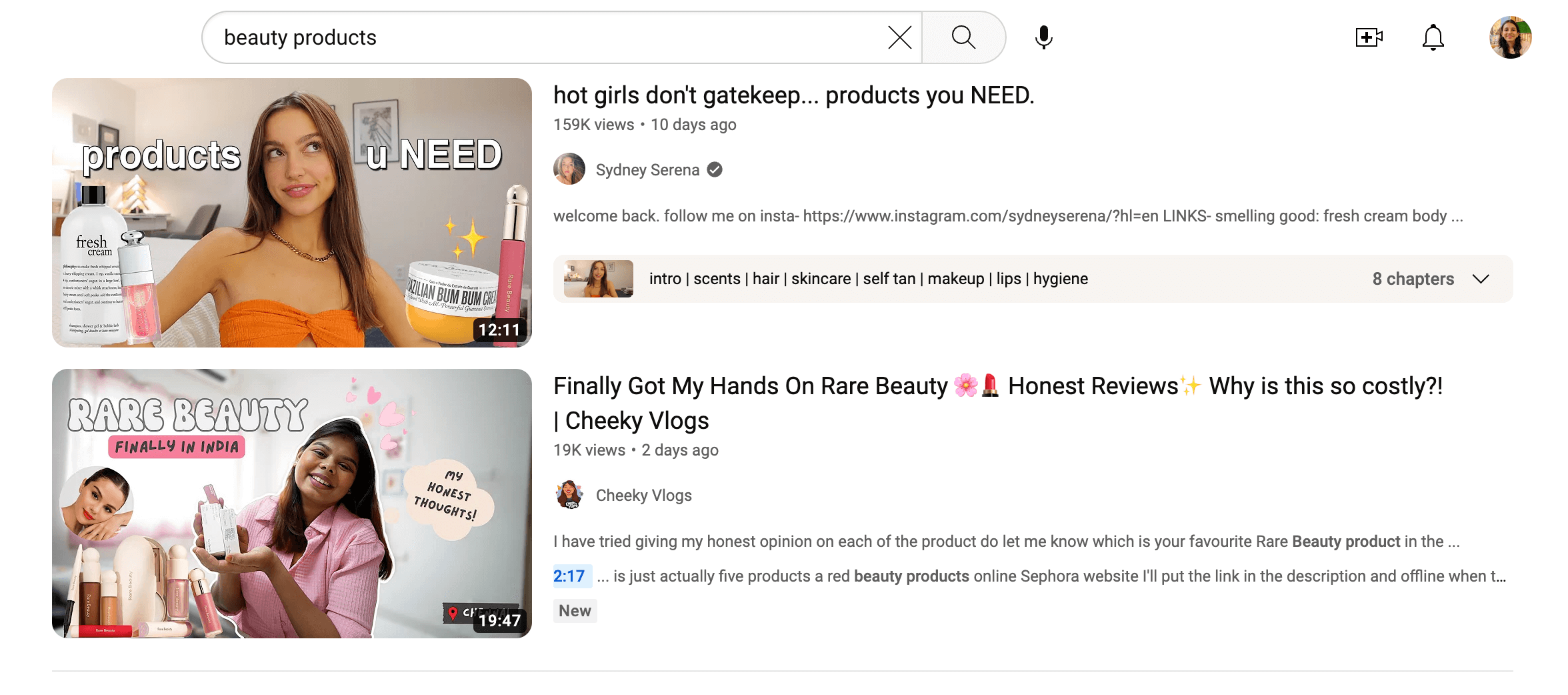
Twitter also has an excellent advanced search functionality for researching influencers who are thought leaders on niche topics.
2: Find influencers who are following you already
Many small creators might be already creating user-generated content for your brand. Monitor your follower list and track who’s tagging you in their posts using social listening.
For example, skincare influencer, Vanessa Lindemann, regularly posts non-sponsored skincare reviews. Brands she’s posting positively for can approach her for collaboration — it’d be a solid partnership since she already likes their products.
Similarly, you can also check if any of your recent customers have a decent following on social networks. There’s no better brand advocate than a happy customer.
⚡Pro-tip: Ask your customers who they follow and trust online. This way, you take influencer recommendations right from the source to find your best-fit creator partners.
3: Find influencer lookalikes
If you’ve found an influencer you like, social media channels do the job of recommending similar influencers. Spot the downward arrow on Instagram and TikTok ( “⬇️”) and filter for “related” content on your YouTube recommendations.
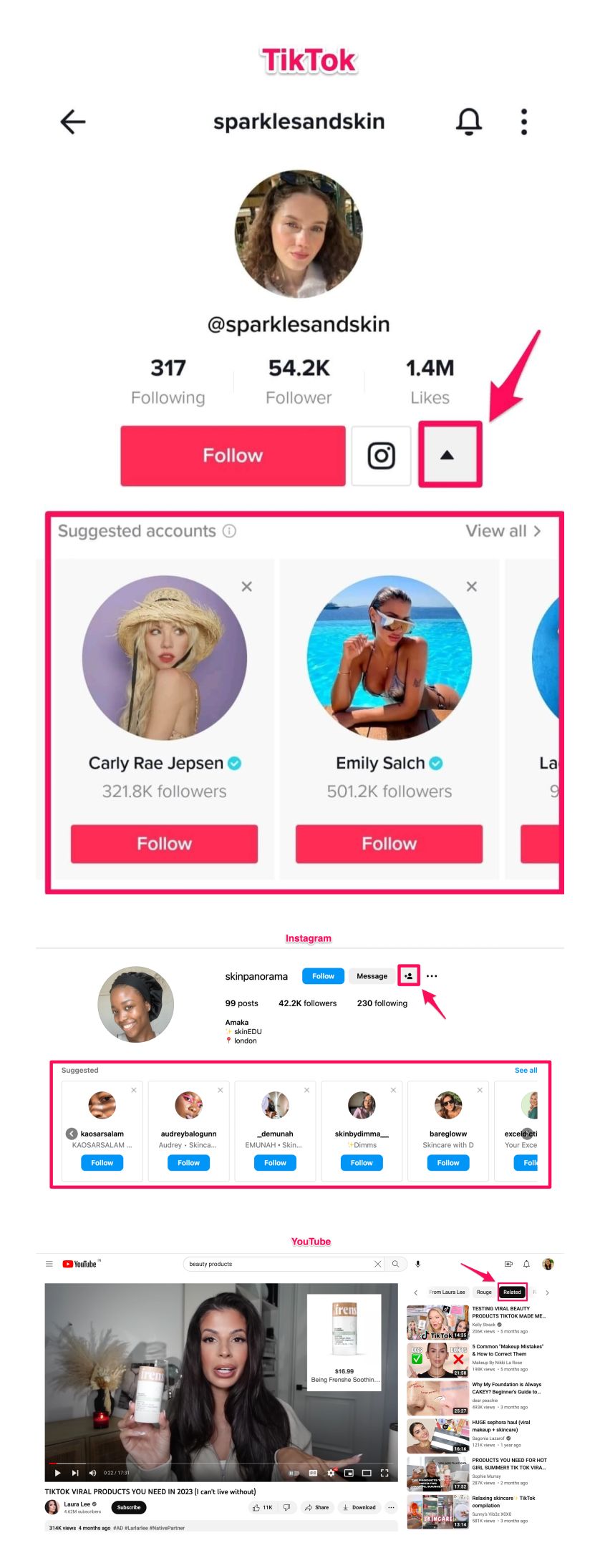
The algorithm of all social media platforms will also work to show you similar content by various creators. So spend some time on each channel to train the algorithm to your brand interests.
Step 4: Start reaching out to influencers
Once you’ve shortlisted influencers, the next step is to start reaching out to them. Where should you reach out to influencers? Email is the right choice since DMs might get buried under other messages — especially for popular influencers. You can use DMs to follow up with creators after your first email outreach.
Where do you find influencer emails? If you’re using any influencer marketing software, emails might be available inside the software itself. If not, influencers share their email publicly.
- On TikTok, influencers share their email in their bios.
- On YouTube, it’s under the “about” section in their channel.
- On Instagram, either the influencer will have an email in their bio, or there’s a separate email button on the app.
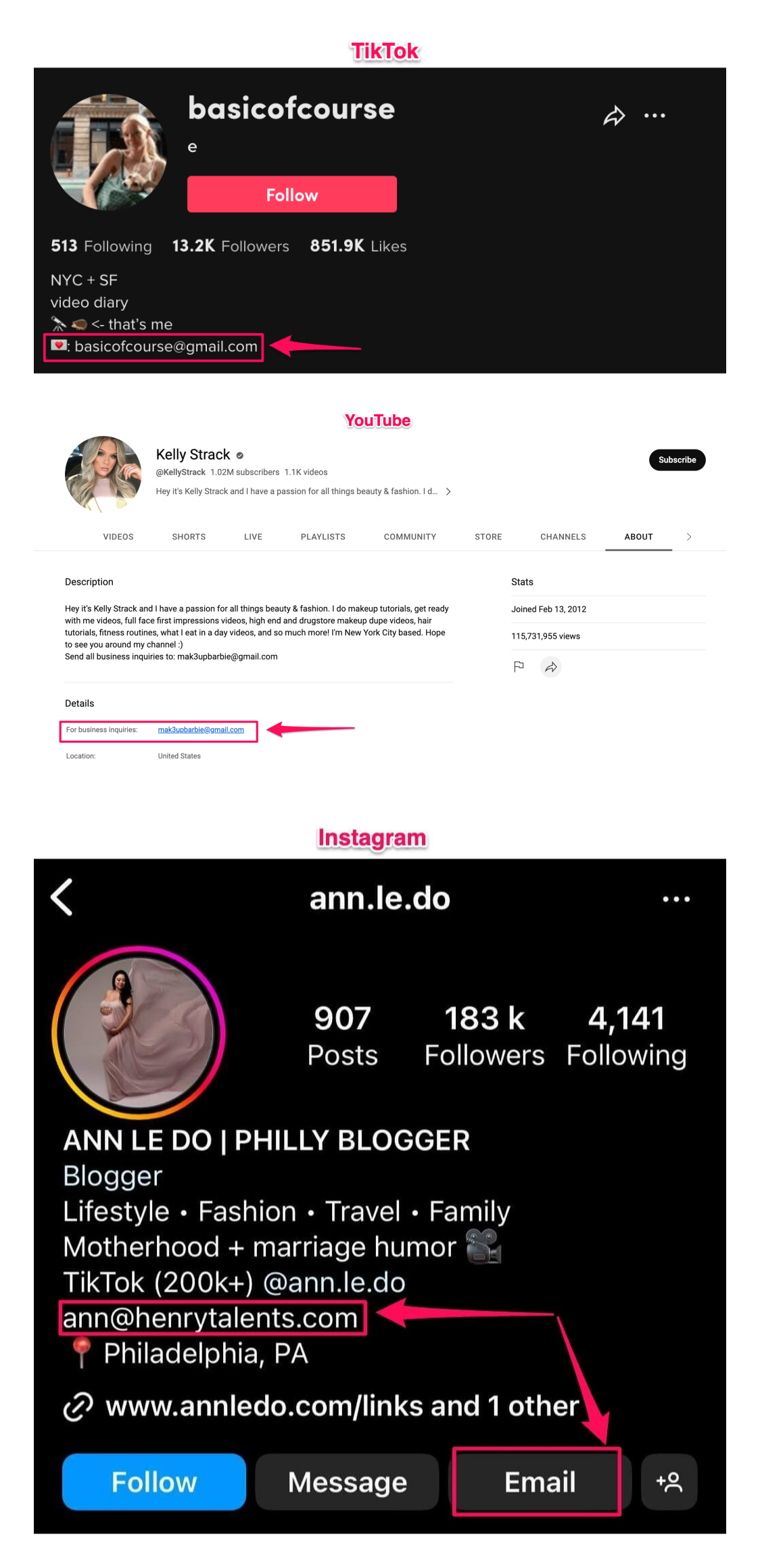
⚡ Remember: If the email-in-bio and email-in-button differ for any Instagram influencer, read the influencer’s bio. It’ll likely have an email marked for brand collaborations. If not, send your outreach message to both emails.
For other social media platforms like Pinterest, Twitch, LinkedIn, and Twitter, check the influencer’s bios for the correct email address. If there’s no email address in the bio:
- Check their Instagram, Twitter, TikTok, or YouTube profile for an email address
- See if they have an email present on their landing page or website
- DM them to ask them for the right email address
What should your influencer outreach email say? It depends on the type of influencer collaboration you’ve chosen. If you’re sending a no-strings-attached gift to influencers, your message should say that. Similarly, your ask will be different if you’re looking for influencers for a paid sponsored post.
Here’s a template you can build off from:
“Hey [influencer name],
I’m [your name], the [your job role] at [your company’s name]. I’m reaching out because we love your content and wanted to ask if you’d be interested in a partnership?
We like you because [mention why you chose the influencer] and our products would help your audience [describe how your product is beneficial for their audience].
You’d be a perfect fit for our [details about your influencer marketing campaign].
Interested? Shoot me a reply, and we’ll take it from there!”
Customizing what you’re saying to each influencer is crucial. An influencer might receive many emails from brands like yours every day — personalizing is an easy way to stand out.
⚠️ Remember: Don’t use words like “free” in your email subject lines. Email providers might notice a pattern and mark you as spam, or influencers might tune you out, thinking you want free content. Use something that leverages the curiosity gap, like: “We think [your brand name] and [the influencer name] are an instant right swipe!”
Struggling to get replies from influencers? Don’t lose heart. Follow up a few times before pausing for a few months and regauging an influencer’s interest in your offer.
If you get no reply, understand that it wasn’t meant to be and find other influencers who might be a better fit. Don’t take the lack of a response personally!
If you have had low response rates from influencers across the board for a long time, ask for feedback from your peers or a creator on your outreach message.
Step 5: Set up influencer marketing logistics
Influencer marketing is a ton of admin work. Before beginning any partnership, you must have:
- An official influencer contract
- Influencer briefs for each campaign or post
- Established in-house processes for payment, tracking, and communication
Let’s cover these three aspects in more detail.
An influencer contract
Contracts are non-negotiable, no matter how much you trust the influencer. It makes things official, and you have something to refer back to in case of disagreements.
What should go into an influencer contract?
- Data you’d require from the influencer for measuring campaign success
- Ownership details about influencer-generated content
- FTC guidelines and other legal requirements
- Timelines of submission, approval, and posting
- Content production and distribution process
- Payment method and payment terms
- Campaign Goals and KPIs
⚠️ Remember: Some influencers might charge extra for transferring ownership of their content to your brand — especially if you want it permanently. This cost is worth it because you can repurpose influencer-generated content into paid ads, display it on your website, or reshare it on your brand socials.
Learn more: How These Small Businesses Repurpose Content
Influencer briefs for each campaign or post
Influencer briefs are context-dependent, depending on your type of collaboration and the freedom you want to offer to the influencer. Include:
- An overview of your company and campaign goals (keep it concise)
- Deliverables the influencer owes you with timelines (posts, videos, and everything else)
- Legal disclosure on how to signify the partnership (FTC guidelines, where in caption should the disclosure be)
- Guidelines on caption and visuals (what they should write, where they should get their free images from)
⚡ Pro-tip: While you should include some guidelines on captions and visuals, offer creative liberty to your influencer partners. They know what works best with their audience — and you don’t want your collaborative post to feel like an ad by putting words in their mouth.
Established in-house processes for payment, tracking, and communication
Who is responsible for communicating with influencers, ensuring they post on time & submit by the deadline, monitoring their post performance, and tracking their payment?
Depending on your team size and structure, have these processes in place before beginning influencer partnerships. Knowing who is responsible for what tasks guarantee accountability and clarity. It also makes your influencer relationships a smooth experience.
Tracking influencer posts is doable when you’re partnering with a handful of influencers for one campaign. But what happens as you begin to scale your efforts? The thought of manually tracking hundreds of influencer content can cause the most efficient marketers to break a sweat. Don’t worry: Use Buffer’s tags feature to attribute influencer posts to the right campaign.
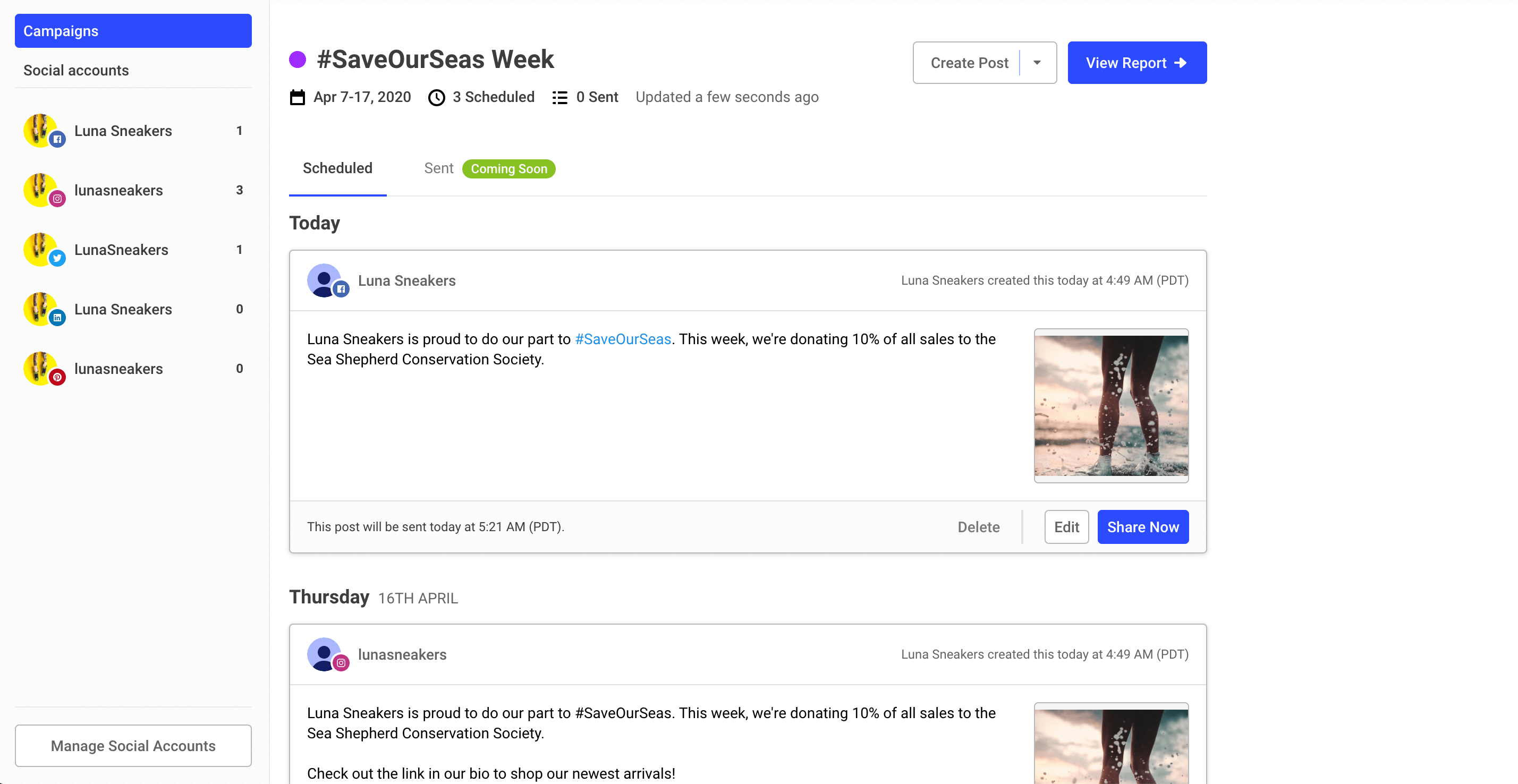
Not only can you track posts easily with this feature, but also measure performance. Buffer has a detailed report for each campaign — including posts, impressions, engagement, comments, and more.

You can also export all this data and build custom reports on Buffer — sharing data points on each campaign with stakeholders.
Take a free trial of Buffer to access this feature today.
Influencer marketing is a long game
The thing about influencer marketing is it isn’t a quick one-and-done game. You need some time to nourish influencer relationships, experimentation to find out what works best for your audience, and patience to see positive results.
But the payoffs are worth it — authentic marketing, instant consumer trust, and (eventually) an uptick in sales.
Hopefully, with this guide, you know how to grab your slice of the influencer marketing industry.




